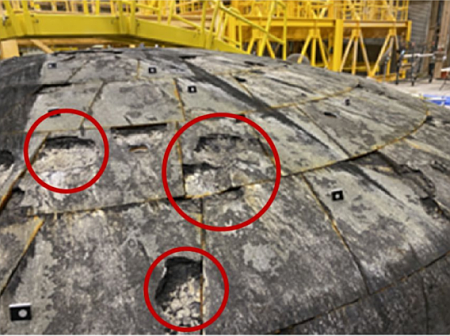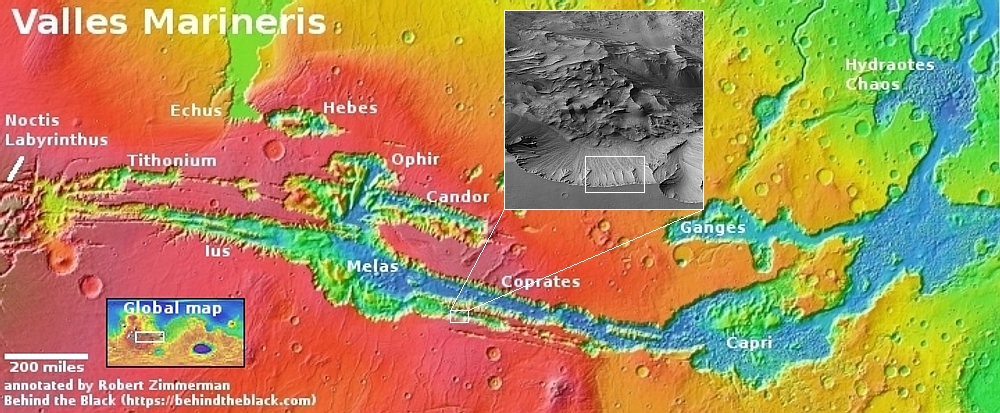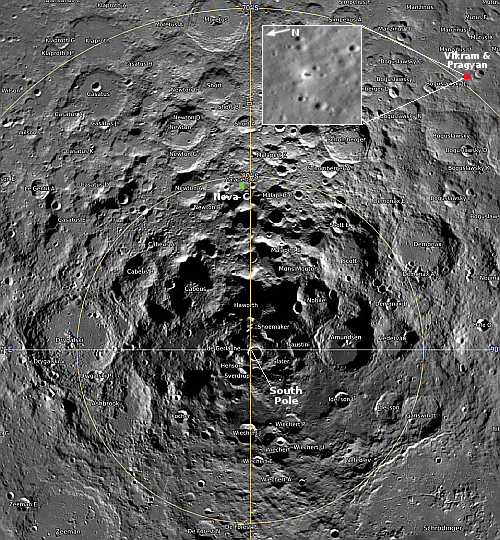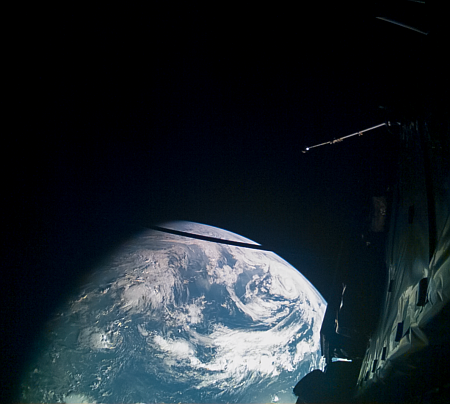Ringo Starr, Robbie Robertson, & many others – The Weight
An evening pause: It remains amazing how pervasive the music of the 1960s remains, worldwide.
Hat tip Mike Nelson for providing this nice way to go into the weekend.
An evening pause: It remains amazing how pervasive the music of the 1960s remains, worldwide.
Hat tip Mike Nelson for providing this nice way to go into the weekend.
Courtesy of BtB’s stringer Jay. This post is also an open thread. I welcome my readers to post any comments or additional links relating to any space issues, even if unrelated to the links below.
Only one today from Jay. A quiet day.
The German company is to supply the optical terminals that the satellites will use to send and receive laser signal, and its contract involves supplying these terminals to four other companies in their contracts with the Pentagon. It apparently is having problems scaling up the production of these units from making a few to many in order to serve a plethora of constellations.
On Christmas Eve 1968 three Americans became the first humans to visit another world. What they did to celebrate was unexpected and profound, and will be remembered throughout all human history. Genesis: the Story of Apollo 8, Robert Zimmerman's classic history of humanity's first journey to another world, tells that story, and it is now available as both an ebook and an audiobook, both with a foreword by Valerie Anders and a new introduction by Robert Zimmerman.
The print edition can be purchased at Amazon or any other book seller. If you want an autographed copy the price is $60 for the hardback and $45 for the paperback, plus $8 shipping for each. Go here for purchasing details. The ebook is available everywhere for $5.99 (before discount) at amazon, or direct from my ebook publisher, ebookit you don't support the big tech companies and the author gets a bigger cut much sooner.
"Not simply about one mission, [Genesis] is also the history of America's quest for the moon... Zimmerman has done a masterful job of tying disparate events together into a solid account of one of America's greatest human triumphs."--San Antonio Express-News

Even Robert Kennedy agrees with this now
Below I have embedded in its entirety Robert Kennedy Jr.’s speech today where he announced he has suspended his campaign, endorsed Donald Trump for president, and declared he will campaign for him.
You should watch it, especially beginning from around seven minutes into the speech, when he begins to describe at length the tyrannical anti-democratic nature of today’s modern Democratic Party, and why that nature has forced him to leave that party, the party of his father, Robert Kennedy and his uncle, John Kennedy, to which he has belonged since he was a child. The key quote:
I attended my first Democratic convention at the age of six in 1960 and back then, the Democrats were the champions of the Constitution of civil rights. The Democrats stood against authoritarianism against censorship against colonialism, imperialism and unjust wars. We were the party of Labor of the working class. The Democrats were the party of government transparency and the champion of the environment. Our party was the bulwark against big money interests and corporate power. True to its name. It was the Party of Democracy.
As you know, I left that party in October because it had departed so dramatically from the core values that I grew up with. It had become the party of war censorship, corruption, big Pharma, big tech big ag and big money wanted abandoned democracy by canceling the primary to conceal the cognitive decline of the sitting president.
He now sees Trump as the only way now to prevent this party of censorship and corruption from destroying our great nation.
This quote however does not give you the full flavor of his speech. It is nuanced, thoughtful, educated, and principled. You might not agree with everything he believes, but you will discover that he came to those beliefs based on rational thought, reasoned research, and critical thought. And it is that ability to think critically and openly about the Democratic Party — that he and his family have been an integral part for more than half a century — and to reject it and endorse Donald Trump. It is therefore incumbent upon every American citizen to do the same, to use our brains to make a thoughtful (not emotional) choice in November.
Which means it is incumbant upon everyone to spend a short 40 minutes to watch this speech. If you run it at 1.5 speed you can still understand everything, it will take less time.
» Read more

Cool image time! The picture to the right, cropped to post here, was taken on May 23, 2024 by the high resolution camera on Mars Reconnaissance Orbiter (MRO).
The white dot in the inset of the overview map above indicates the location on Mars, smack dab in the middle of the 2,000-mile-long mid-latitude strip that I call glacier country, because practically every close-up image of this region shows glacial features.
This picture is no exception. The arrows in the inset show the downhill grade, falling about 1,700 feet across the entire inset. That grade is a reflection of the transition that takes place in this glacier country from the cratered southern highlands to the northern lowland plains.
I decided to crop the image at full resolution — showing only a tiny portion — because to my eye these curving linear grooves, produced naturally as Mars’ climate cycles cause glaciers to shrink and then grow repeatedly so that each cycle lays down a new line while squeezing the previous lines, are almost like a work of art. This might be nothing more than a glacier on an alien planet, but nature has caused it to form a very beautiful picture.
Now available in hardback and paperback as well as ebook!
From the press release: In this ground-breaking new history of early America, historian Robert Zimmerman not only exposes the lie behind The New York Times 1619 Project that falsely claims slavery is central to the history of the United States, he also provides profound lessons about the nature of human societies, lessons important for Americans today as well as for all future settlers on Mars and elsewhere in space.
“Zimmerman’s ground-breaking history provides every future generation the basic framework for establishing new societies on other worlds. We would be wise to heed what he says.” —Robert Zubrin, founder of the Mars Society.
All editions are available at Amazon, Barnes & Noble, and all book vendors, with the ebook priced at $5.99 before discount. All editions can also be purchased direct from the ebook publisher, ebookit, in which case you don't support the big tech companies and the author gets a bigger cut much sooner.
Autographed printed copies are also available at discount directly from the author (hardback $29.95; paperback $14.95; Shipping cost for either: $6.00). Just send an email to zimmerman @ nasw dot org.
NASA yesterday added three orbital tug startups to its contract bid list, allowing these companies to bid on projects that require the deployment of NASA smallsats to different orbits after launch.
NASA announced Aug. 22 that it selected Arrow Science and Technology, Impulse Space and Momentus Space for its Venture-Class Acquisition of Dedicated and Rideshare (VADR) contract. That selection allows them to compete for task orders for launching specific missions, typically small satellites willing to accept higher levels of risk in exchange for lower launch costs.
Arrow provides small satellite companies the deployment equipment used to release the satellite after launch. Impulse and Momentus have orbital tugs that not only deploy smallsats, but move them to their preferred orbit after the tug’s release from its launch rocket.
This NASA announcement allows its smallsats to be launched on either a dedicated small rocket that puts the satellite in its desired orbit or as part of a larger rideshare launch with many satellites that then uses the tug to get the satellite where it needs to be.
Amazon yesterday revealed it is going to spend an addition $19.5 million to expand its satellite production facility at the Kennedy Space Center in Florida in order to overcome the long multi-year delay in getting production started.
The company said Aug. 22 the investment will support a secondary, 3,900-square-meter support facility at the site, which would help accelerate launch cadence amid a looming regulatory deadline to deploy half the constellation by July 2026. The building would join a 9,300-square-meter satellite processing facility Amazon announced last year at Kennedy’s runway-equipped Launch and Landing Facility, bringing total investment in the site to nearly $140 million.
The company hopes to open this additional facility by next year. It will need it, because its FCC license for its Kuiper internet constellation — conceived to be similar to SpaceX’s Starlink — requires it to launch half of the constellation of 3,200+ satellites by 2026 and have the entire constellation in orbit by 2029. Meeting that first deadline will be challenging at this point, though the company hopes to be launching frequently in the next few years. It has contracts to launch satellites 46 times on ULA rockets (8 on Atlas-5 and 36 on Vulcan), 27 times on Blue Origin’s New Glenn, 18 times on ArianeGroup’s Ariane-6, and 3 times on SpaceX’s Falcon-9. To provide payloads for those launches however it will need to be able to quickly build a lot of satellites, and that’s what this additional investment is for.
It must be noted again that the Kuiper constellation was first proposed by Amazon at almost the exact same time as Elon Musk proposed his Starlink constellation. SpaceX now has several thousand satellites in orbit and is earning several billion dollars per year from several million signed up customers. Amazon in comparison has only launched two test satellites and zero operational satellites in that same time frame.
Leaving Earth: Space Stations, Rival Superpowers, and the Quest for Interplanetary Travel, can be purchased as an ebook everywhere for only $3.99 (before discount) at amazon, Barnes & Noble, all ebook vendors, or direct from my ebook publisher, ebookit.
If you buy it from ebookit you don't support the big oppressive tech companies and I get a bigger cut much sooner.
"Leaving Earth is one of the best and certainly the most comprehensive summary of our drive into space that I have ever read. It will be invaluable to future scholars because it will tell them how the next chapter of human history opened." -- Arthur C. Clarke

Proposed spaceports surrounding Norwegian Sea
The Norwegian government announced yesterday that the Andoya spaceport that has been used for decades for suborbital test launches, has been given a spaceport license to conduct orbital launches from the site.
According to a statement from the Norwegian ministry, the license allows the spaceport to conduct up to 30 launches a year, including four during overnight hours. Those launches, to be overseen by the Civil Aviation Authority of Norway, can take place on azimuths between 280 and 360 degrees, supporting missions primarily to polar and sun-synchronous orbits.
The German rocket startup Isar Aerospace already has a 20-year lease to conduct orbital launches from Andoya, and hopes to do the first orbital test launch of its Spectrum rocket there. According to the Norway government, the first launch is planned for this year, but that likely will only be a suborbital test, not a full orbital launch. Of the three rocket startups from Germany, Isar is the only one that has not yet done any engine tests (as far as we know) or suborbital test launches of its rocket engine or design. Hyimpulse has done a suborbital test launch from an Australian spaceport, and Rocket Factory Augsburg have done numerous tests both in Germany and at the Saxaford spaceport. This license to Andoya will likely signal the start of those public tests by Isar.
A fourth European rocket startup, PLD from Spain, is presently prepping its own launchpad in French Guiana, and hopes to conduct its own first orbital test launch next year.
Until this week it appeared that Rocket Factory was in the lead to be the first European rocket startup to attempt an orbital launch. That changed when the rocket’s first stage was destroyed during a static fire launchpad engine test earlier this week. Right now it is not clear who is in the lead.
According to Rocket Factory Augsburg, its investigation into the explosion during the first full nine-engine static fire test of its RFA-1 rocket earlier this week has identified the cause of the failure.
In an update on LinkedIn on 22 August, RFA COO Dr. Stefan Brieschenk announced that the company had completed an initial internal review. In what Dr. Brieschenk describes as “very preliminary” findings, he explains that the company has identified an “oxygen fire in one of the turbopumps” as the root cause of the incident. “That engine and that turbopump have run before without issues, wrote Dr. Brieschenk. “Eight engines ignited. We had multiple back-up and safety systems in place that were supposed to shut everything down – but things did not align on Monday as planned.”
As he notes, this is very preliminary. The company probably still does not know why the fire occurred in that turbopump, and it will need to find out in order to fix the problem. And without that fix, it is almost certain the UK’s Civil Aviation Authority (CAA) will not issue the company a launch license when a new first stage is built and delivered to the Saxavord spaceport in the Shetland Islands where the launch is planned.
All in all, expect a delay of at least one year before that launch can occur. Base on the CAA’s past history, that delay could easily extend to two years.
According to a NASA update today, the agency will hold “an internal Agency Test Flight Readiness Review” to discuss whether to return Starliner manned or unmanned on Saturday morning, August 24, 2024 and then hold a press conference immediately afterward to discuss the results of that review.
What makes this review and press conference different from all previous Starliner reviews and conferences is that NASA administrator Bill Nelson will attend.
NASA Administrator Bill Nelson and leadership will hold an internal Agency Test Flight Readiness Review on Saturday, Aug. 24, for NASA’s Boeing Crew Flight Test. About an hour later, NASA will host a live news conference at 1 p.m. EDT from the agency’s Johnson Space Center in Houston.
The only reason a politico like Nelson would participate in such proceedings is because he has taken control of the decision-making process, and will make the decision himself. The review is likely to educate him as best as can be done in this short time, and he will then decide whether the two astronauts who launched on Starliner, Butch Wilmore and Suni Williams, will return on it in the next week or so, or will stay on board ISS until February 2025 and return on the next Dragon crew capsule scheduled to launch to ISS in late September.
Nelson might have decided to get involved on his own, but I am certain that if so it was strongly “encouraged” by officials above him in the White House. There is an election coming up, and the risks involved in using Starliner to return the astronauts must be weighed in connection not just with its engineering concerns but with its political ramifications also.
Nelson’s decision will also provide us a strong indication of a future Harris administration’s attitude toward space.
Courtesy of BtB’s stringer Jay. This post is also an open thread. I welcome my readers to post any comments or additional links relating to any space issues, even if unrelated to the links below.
The data comes from TESS in orbit, and is among the plethora of new exoplanets that spacecraft has found in its monthly survey of 93% of the sky.
The tweet includes a video (with dramatic music to make something already exciting seem like a fake movie) in which it appears the hatch for the spacewalk during this mission is not going to be at the top, where Dragon capsules have had their docking port, but on the side.
Launch is targeting 2028. The telescope’s program will be similar to Kepler, looking at the same regions in the sky over four years in the specific hope of detecting an Earth-sized planet in the habitable zone.
The tweet includes some samples, as does this different tweet. The release will celebrate the one year anniversary of Vikram’s lunar landing.
In other words, he made it into space, which explains why he was finally awarded astronaut wings in 2005. Too bad he had passed away before the honor was bestowed him.

Trump defiant
Today I saw a short clip of Donald Trump answering a question about whether he is getting the normal intelligence briefings traditionally given to all presidential candidates. His answer was startling:
Well I could [get them] if I wanted them, but I don’t want them. … They come in, they give you a briefing and then two days later they leak it and then they say you leaked it. The only way to solve that problem is not to take them.
On its face Trump is simply telling us he is now being careful with whom in the government he deals with. On a deeper level, he is showing us that he is no longer the naive businessman he was in 2016. At that time he wanted very much to reform Washington, but he thought he had the good will of the people in Washington to help him do it. (Remember, for most of his life he was a dedicated Democrat with many friends on the left.)
Instead, he found himself stymied and back-stabbed and attacked on all levels. » Read more

Proposed concept for extracting water from
lunar regoilth
Chinese scientists have found that by heating Chang’e-5 lunar samples to 1,700 degrees Fahrenheit it is possible to extract a significant amount of water. From the paper’s abstract:
FeO and Fe2O3 are lunar minerals containing Fe oxides. Hydrogen (H) retained in lunar minerals from the solar wind can be used to produce water. The results of this study reveal that 51–76 mg of H2O can be generated from 1 g of LR [lunar regolith] after melting at temperatures above 1200 K. This amount is ∼10,000 times the naturally occurring hydroxyl (OH) and H2O on the Moon. … Our findings suggest that the hydrogen retained in LR is a significant resource for obtaining H2O on the Moon, which are helpful for establishing scientific research station on the Moon.
A video in Chinese (hat tip BtB’s stringer Jay) that describes this research can be found here. (If any of my readers understands Chinese and can provide a translation of this video’s narration, I would be very grateful.) It includes an artist’s rendering (screen capture to the right) showing how such a system on the Moon could work to extract water from the soil. Sunlight would be focused by a lensed mirror into a glass-domed container, heating the ground. The water would evaporate, condense on the glass and be sucked into a tube that would transfer it to a water tank.
This design is of course very simple and preliminary. According to Jay, “They need to heat the soil to 1000℃ (1832°F) to get the iron oxide in the lunar soil to split, the oxygen combines with hydrogen to make water and iron (melting point of iron is about 1500℃). You will need a nuclear reactor to produce that much power for an inductive furnace to get that hot. Doing the calculation, it would take about 245kw to heat up a metric ton of dirt in one hour to a 1000℃ degrees. It could be done slower over 24 hours at 10kw.”
Despite the technical difficulties getting such equipment operational on the Moon, that this research suggests water can be produced practically anywhere on the lunar surface is signficant. It suggests that even if no easily accessible water ice is found in the permanently shadowed craters at the poles, lunar bases still have viable options for obtaining water, and they don’t have even be at the poles.
China today successfully launched a new communications satellite, its Long March 7A rocket lifting off from its coastal Wenchang spaceport.
A short clip showing the launch can be found here. (Hat tip to BtB’s stringer Jay.)
The leaders in the 2024 launch race:
83 SpaceX
35 China
10 Rocket Lab
9 Russia
American private enterprise still leads the rest of the world combined in successful launches 98 to 53, while SpaceX by itself still leads the entire world combined, including American companies, 83 to 68.
A plan to build a new terminal in Port Canaveral for the large cruise lines has now been dropped because the constant arrival and departure of those ships would hinder launches from both Cape Canaveral as well as the Kennedy spacport.
On Aug. 2, Florida Department of Commerce Secretary J. Alex Kelly and Florida Department of Transportation Secretary Jared Perdue expressed dismay about cruise-terminal plan changes that could affect the space industry. Kelly and Perdue, in a letter, said that unless the port returns to earlier plans for the berth, the Department of Transportation will shift investments to other seaports and spaceports, and the Department of Commerce will halt funding for Port Canaveral projects.
These threats were enough to cause the port to drop its plans.
This story strongly suggests that the Florida state government views the future income from spaceport operations to far exceed that of the tourist cruise business, and does not wish the latter to interfere with the former’s growth in any way.
The proposed commercial spaceport in Nova Scotia that was first proposed by the company Maritime Launch Services in 2017 has now signed a partnership deal with the space station company Voyager Space.
Voyager, through its Exploration Segment, will provide comprehensive engineering, design and fabrication support to Maritime Launch, leveraging more than six decades of combined aerospace and defense technology experience. Voyager will bring its decades of commercial spaceflight engineering, manufacturing, and operations capabilities to provide engineering design and development and buildup of select portions of the launch site on behalf of Maritime Launch. Voyager will work alongside Maritime Launch to analyze launch client requirements and integrate them into the current site layout.
Maritime’s original plan had been to provide a launch location and rocket (produced by a Ukrainian company). Satellite companies would sign with both for launch services. The invasion of the Ukraine by Russia in 2022 killed that arrangement. So did red tape, as the Canadian government only passed a law allowing spaceports to make deals with international partners at the start of August.
It appears Maritime has realized that without that rocket partner, it needs another experienced partner to help build the spaceport itself and make sure launches by many different rocket companies are done safely. It has now hired Voyager to do this, since that company is leading the Starlab space station consortium that includes many very experienced companies, including Lockheed Martin, Northrop Grumman, Airbus, Mitsubishi, and the European Space Agency.

Damage to Orion heat shield caused during re-entry in 2022,
including “cavities resulting from the loss of large chunks”
Because the damage to the heat shield on the Orion capsule that flew around the Moon in late 2022 remains somewhat unexplained, NASA is considering delaying the next SLS/Orion mission, presently planned for September 2025 and intended to be the first Artemis flight to carry humans and take them around the Moon.
The heat shield, already installed at the base of the Orion spacecraft, will take the brunt of the heating when the capsule blazes through Earth’s atmosphere at the end of the 10-day mission. On the Artemis I test flight in late 2022, NASA sent an Orion spacecraft to the Moon and back without a crew aboard. The only significant blemish on the test flight was a finding that charred chunks of the heat shield unexpectedly stripped away from the capsule during reentry as temperatures increased to nearly 5,000° Fahrenheit (2,760° Celsius).
The spacecraft safely splashed down, and if any astronauts had been aboard, they would have been fine. However, the inspections of the recovered spacecraft showed divots of heat shield material were missing.
Two years later, despite extensive investigation and analysis, it appears NASA has not yet identified the root cause of the damage. The ablative material used on Orion was similar (though not identical) to the material used successfully on numerous other heat shields since the 1960s, yet it did not perform as expected.
NASA is presently facing three options. Do nothing and fly the next mission as planned, with four astronauts. It could rethink the trajectory used during re-entry, though this would likely not change things significantly unless the astronauts don’t go around the Moon as planned. Or it could change the heat shield itself.
The first two options are very risky, considering the unknowns. The latter involves a major delay of at least two years.
A decision must be made soon however. To meet the agency’s schedule it must begin stacking SLS’s two solid-fueled strap-on boosters next month. Those boosters have a limited life expectancy originally estimated to be one year. In the first unmanned Artemis test flight in 2022, NASA because of other delays stretched that life span to two years, and had no problems with the launch. If it stacks the boosters now and then has to delay for two more years to redesign Orion’s heat shield, those boosters will have been stacked for three years when launched.
Considering how seriously NASA is taking the issues with Starliner, which are likely not as serious as a heat shield that doesn’t work reliably, it would seem insane for NASA to launch Orion manned without fixing its own problem. And yet, for more than two decades NASA has consistently not demanded the same safety standards for SLS that it has demanded for the private commercial rocket startups. We shall see if this pattern now persists.
I continue to believe that the first Artemis lunar landing will not take place before 2030 (at least six years behind schedule). This heat shield dilemma only strengthens that prediction.
Embedded below the fold in two parts.
To listen to all of John Batchelor’s podcasts, go here.
» Read more
Courtesy of BtB’s stringer Jay. This post is also an open thread. I welcome my readers to post any comments or additional links relating to any space issues, even if unrelated to the links below.
The engine is for the company’s proposed lunar landers. I can’t help noticing how complex it is compared to SpaceX’s more recent engines.
The tweet says that the rockets are “Long March 7A in transfer and the Long March 12 in integration.”
The company still hasn’t successfully flown a rocket, but without doubt, its 3D printing operation gives it an asset it can sell for billions.
All will fly on its largest rocket, using two different configuations. The image suggests it is following the simple design concepts first used by the Soviets and since copied by the Chinese.
It flew past Jupiter, Saturn, Neptune, and Uranus before leaving the solar system. Also, two years earlier on this same day Viking 1 was launched to Mars.

The accused slanderers still serving on Denver’s Board of Education.
Click for details about each.
Fight! Fight! Fight! Kristen Fry, a parent in Denver, has now sued the four members of the Denver school board who teamed up with a political consultant they worked with to falsely accuse her of assaulting that political consultant at a public board meeting while also using a vicious racial slur against him.
Fry had been part of a group of parents and teachers that were desperately trying to get this board to change its policies in the schools that had were allowing violence to run rampant From Fry’s lawsuit [pdf]
In the period leading up to 2022-23 school year, the BOE [Board of Education] defendants pursued a number of significant changes to DPS [Denver Public Schools] policy that had severe consequences for the educational and safety environment in DPS schools.
Among other things, in an initiative spearheaded by Mr. Anderson, and supported by the other defendants, DPS removed public safety officers from district schools because of purported racial inequities in disciplinary enforcement. DPS further replaced clear behavioral and accountability rules with what are sometimes termed “restorative justice” principles that often have the effect of leaving students (especially low-income students) vulnerable to disruptive and even criminal behavior by their classmates. For example, under the new rules, schools were required to allow potentially violent students, including students facing criminal charges such as robbery and attempted murder, to attend in person, even where against the advice of law enforcement authorities.
These policies were doing nothing but bring chaos and violence to the schools, while seriously degrading the learning environment. The parents, teachers, and even students repeatedly attempted in private and in public to convince the board its policies were not working.
In every case, this effort was met with anger, disrespect, and retailation by the board. In one case the board immediately terminated a principal for expressing dissent about their policies to a television news reporter. In the case of Fry, these thugs not only repeated these false claims against her in many public forums, they teamed up to file criminal charges against her.
» Read more

Cool image time! The picture to the right, rotated, cropped, reduced, and sharpened to post here, was taken on May 24, 2024 by the high resolution camera on Mars Reconnaissance Orbiter (MRO). Labeled merely a “terrain sample” by the camera team, it was likely taken not as part of any particular research project, but to fill a gap in the picture-taking schedule in order to maintain the camera’s proper temperature.
When the camera team needs to do this, they try to pick interesting targets within the required timeframe. Sometimes they succeed, sometimes not. In today’s example, they succeeded quite well. As shown by the overview map above, this picture captures (as indicated by the rectangle) the top of the southern rim of Valles Marineris, the biggest canyon on Mars and quite possibly the biggest in the entire solar system.
For scale, the drop from the rim to the low point in this picture is about 9,000 feet. That’s a 1,000 feet more than the drop from the north rim of the Grand Canyon to the canyon bottom at the Colorado River. In Valles Marineris however our descent has barely begun. To get to the bottom of the southern canyon here you still need to drop 15,000 more feet, for a total descent of 24,000 feet, an elevation change similar to most of the mountains in the Himalayas.
Nor are you yet at the bottom. If you climb over the ridge of 18,000-foot-high mountains that bisect Valles Marineris at this point, you can drop down even further, to a depth 31,000 feet below the southern rim.
Mount Everest is just over 29,000 feet high, which means if placed inside Valles Marineris is peak would still sit 2,000 feet below the rim.
The photo itself highlights part of the erosion process that formed Valles Marineris. This is the dry tropics, so no water was involved in shaping this terrain for many eons. Instead, what appear to be flows within the hollows is alluvial fill, material that over time breaks off and rolls downhill, filling the slopes below. Erosion will grind this material into smaller particles, so given enough time it flows almost like sand.

Vikram as seen by Lunar Reconnaissance Orbiter.
Click for interactive map. To see the original
image, go here.
Data from India’s Pragyan lunar rover that landed in the high southern latitudes of the Moon in August 2023 has now confirmed the theory that the Moon’s surface was once largely covered with molten lava oceans.
Santosh Vadawale, an X-ray astronomer at the Physical Research Laboratory in Ahmedabad, India, and his colleagues analysed radiation data collected by the APXS [one of Pragyan’s instruments], and used this information to identify the elements in the regolith and their relative abundances, which, in turn, revealed the soil’s mineral composition. The team found that all 23 samples comprised mainly ferroan anorthosite, a mineral that is common on the Moon. The results were reported in Nature today.
“It’s sort of what we expected to be there based on orbital data, but the ground truth is always really good to get,” says Lindy Elkins-Tanton, a planetary scientist at Arizona State University in Tempe.
Previous landers obtained similar results. However, the Chandrayaan-3 samples are the first from the subpolar region: previous landers visited equatorial and mid-latitude zones. Together, this suggests that the composition of the regolith is uniform across the Moon’s surface.
These results are no surprise, but they confirm the global nature of the Moon’s early molten history. More important, they demonstrate that India now has the capability to send landers and rovers to other planets that are also capable of doing real research.
The Japanese orbital tug startup Astroscale has now signed the final deal with Japan’s space agency JAXA to de-orbit the old H2A rocket upper stage that the company is presently flying a demonstration rendezvous and proximity mission dubbed ADRAS-J.
The photo to the right was taken by ADRAS-J in the spring, shortly after it rendezvoused with the stage. The data from this demo mission has not only shown Astroscale’s spacecraft can autonomously rendezvous and fly in close formation to the stage, the stage itself is in excellent condition after fifteen years in space.
The ADRAS-J follow-on active debris removal spacecraft, ADRAS-J2, will similarly attempt to safely approach the same rocket body through [rendezvous and proximity operations], obtain further images, then remove and deorbit the rocket body using in-house robotic arm technologies.
If successful, Astroscale will have the capability to offer this surface to others, both governments and private concerns, thus making the removal of space junk a viable business. Until the past decade, most upper stages ended up in orbit where they remain for long periods. There are a lot of such older stages. Some end up burning up in the atmosphere harmlessly, while others break up in orbit and produce a lot of debris that is a threat to other spacecraft. Astroscale’s mission here will demonstrate the ability to remove such stages.
Astronomers using an array of six ground-based telescopes have obtained best new data of Polaris, the North Star, including the first rough image of its surface, and discovered sunspots on its surface.
You can read the paper here [pdf]. The image to the right, taken from figure 4 of the paper, shows the surface as seen by the telescopes over two nights in April 2021. Polaris is what astronomers call a Cepheid variable star, which changes brightness on a very precise schedule as its diameter grows and shrinks. In the case of Polaris, that variation is four days long. The star’s brightness itself varies only slightly, and over the decades has even at times appeared to cease its variations.
As the true brightness of Cepheids is very predictable based on their pulse rate, these stars are one of the main tools astronomers use to determine distances to other galaxies. Knowing more about them thus has great importance to cosmological research.
The orbital motion showed that Polaris has a mass five times larger than that of the Sun. The images of Polaris showed that it has a diameter 46 times the size of the Sun.
The biggest surprise was the appearance of Polaris in close-up images. The CHARA observations provided the first glimpse of what the surface of a Cepheid variable looks like. “The CHARA images revealed large bright and dark spots on the surface of Polaris that changed over time,” said Gail Schaefer, director of the CHARA Array. The presence of spots and the rotation of the star might be linked to a 120-day variation in measured velocity.
The researchers plan to take regular images again of Polaris to better track the changes to its surface.
In a short FAQ posted by NASA today, the agency quietly revealed that the decision on whether to bring Starliner back with its astronauts on board has been delayed till the end of August.
NASA now plans to conduct two reviews – a Program Control Board and an Agency Flight Readiness Review – before deciding how it will safely return Wilmore and Williams from the station. NASA expects to decide on the path forward by the end of August.
It appears the agency has decided to bring more people into the decision-making process. In the briefing last week, it was then planning only one review, expected to be completed before the end of this week. It now sounds like a second review will occur after the first, pushing the decision back one more week.
All of NASA’s actions in the past three weeks have suggested an increasing involvement by upper management, possibly including White House officials. With an election coming up, the politicans who are supposed to be in charge have apparently inserted themselves into this process and are demanding greater review. I expect in the end the decision will fall to them, and might even be announced by NASA administrator Bill Nelson himself.
These actions have also suggested that upper management does not like the risks involved in returning the crew on Starliner. Politicians do not like to have bad things happen on their watch. We should therefore not be surprised if the decision is made to send Starliner home unmanned.

Earth as seen by Juice during fly-by.
Click for original image.
The European probe Juice yesterday successfully completed a close fly-by of the Earth and was thus successfully slingshoted on its way to its next fly-by, of Venus, on its way to Jupiter.
This fly-by was actually a double event. First Juice zipped past the Moon the day before, coming within 435 miles. Then, only one day later it passed the Earth at a distance of 4,230 miles, thus completing the first dual fly-by of the both the Earth and the Moon.
The flyby of the Moon increased Juice’s speed by 0.9 km/s relative to the Sun, guiding Juice towards Earth. The flyby of Earth reduced Juice’s speed by 4.8 km/s relative to the Sun, guiding Juice onto a new trajectory towards Venus. Overall, the lunar-Earth flyby deflected Juice by an angle of 100° compared to its pre-flyby path.
The inherently risky flyby required ultra-precise, real-time navigation, but is saving the mission around 100–150 kg of fuel. In the month before the flyby, spacecraft operators gave Juice slight nudges to put it on exactly the right approach trajectory. Then they tracked Juice 24/7 between 17–22 August.
The Venus fly-by will occur in August 2025, followed by additional Earth flys in September 2026 and January 2029. The spacecraft will finally arrive in Jupiter orbit in July 2031, where it is designed to study the large icy moons (Europa, Gandymede, and Calisto) of that gas giant.
Courtesy of BtB’s stringer Jay. This post is also an open thread. I welcome my readers to post any comments or additional links relating to any space issues, even if unrelated to the links below.
In 2020 its U.S. subscriber count was 603K. Now it is 257K. The article also notes that Hughes has lost 200K subscribers over that same time period.
The two satellites are part of a planned three-satellite constellation (the third was launched separately and is in Earth orbit) to test orbital communications and navigation technology in retrograde lunar orbits.
Time for another “What the heck?” cool image! The picture to the right, cropped, reduced, and sharpened to post here, was taken on May 23, 2024 by the high resolution camera on Mars Reconnaissance Orbiter (MRO). It shows what the science team labels as “longitudinally aligned cones”.
To my eye the cones visibile in this picture seem more aligned latitudinally, to the east-west, instead of longitudinally, north-south, but the larger view in the inset on the overview map below shows that on a larger scale, the cones do appear aligned in a north-south direction.
Either way, this is one of those photos from Mars orbit that leaves me entirely baffled. The cones and the flow feature that cuts across the middle of the image might be either volcanic or glacial, but it is beyond my pay grade to explain what caused this patch of aligned cones.
» Read more